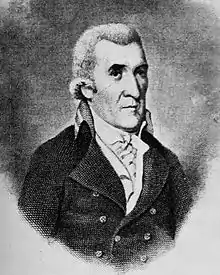William Wright (botanist)
Dr William Wright FRS FRSE FRCPE FLS FSA Scot MWS (1735–1819) was a Scottish physician and botanist. In 1783 he was a joint founder of the Royal Society of Edinburgh.

Life
He was born in March 1735 in Crieff, Perthshire, and was educated at Crieff Grammar School. He served as an apprentice physician with G Dennistoun in Falkirk from 1752 to 1756. He then studied Medicine at University of Edinburgh. In 1758 he joined the Royal Navy as a surgeon, serving in the West Indies until 1763. He obtained his doctorate (MD) from St Andrews University in 1763. ,[1] and became a navy surgeon in 1760.
In 1764 Wright became the assistant to a Dr. Gray in Kingston, Jamaica. He stayed on the island until 1777 then spent two years in London. He enrolled in the British Navy in 1779 and was captured by the French. He returned to Jamaica in 1782 and the following year became Physician in Chief of the colony. He returned to Scotland in 1786, largely living in Edinburgh.
He joined an expedition led by Sir Ralph Abercromby (1734–1801) exploring the Caribbean from 1796 to 1798.

William Wright became a Fellow of the Royal Society in 1778. He was a member in numerous societies, among them the Linnean Society of London of which he became associate member in 1807; the Wernerian Natural History Society in 1808, of which he was a founding member; the Royal College of Physicians of Edinburgh, over which he presided in 1801.[2]
Wright published numerous articles in medicine. His Jamaican collections became an important contribution to natural history. Notably, he described more than 750 plant species.
He lived his final years at 51 Hanover Street in Edinburgh's New Town.[3]
In 1795 he was visited by Johann Gottfried Schmeisser.
He died in Edinburgh on 19 September 1819 and is buried in the north west section of the western extension to Greyfriars Kirkyard. He never married and had no children.[4]
Botanical Reference
The genus Wrightia (Apocynaceae) and Wrightea (syn. Wallichia, Arecaceae) were dedicated to him. Wrightia was by Robert Brown (1773–1858) and Wrightea by William Roxburgh (1759–1815).
Sources
- Ray Desmond (1994). Dictionary of British and Irish Botanists and Horticulturists including Plant Collectors, Flower Painters and Garden Designers. Taylor & Francis and The Natural History Museum (Londres).
- Waterston, Charles D; Macmillan Shearer, A (July 2006). Former Fellows of the Royal Society of Edinburgh 1783–2002: Biographical Index (PDF). II. Edinburgh: The Royal Society of Edinburgh. ISBN 978-0-902198-84-5. Archived from the original (PDF) on 4 October 2006. Retrieved 8 February 2011.
- Dictionary of National Biography. Volume 1. p. 1442 (1903)
- Edinburgh Post Office Directory 1818
- Biographical Index of Former Fellows of the Royal Society of Edinburgh 1783–2002 (PDF). The Royal Society of Edinburgh. July 2006. ISBN 0-902-198-84-X.
- IPNI. W.Wright.